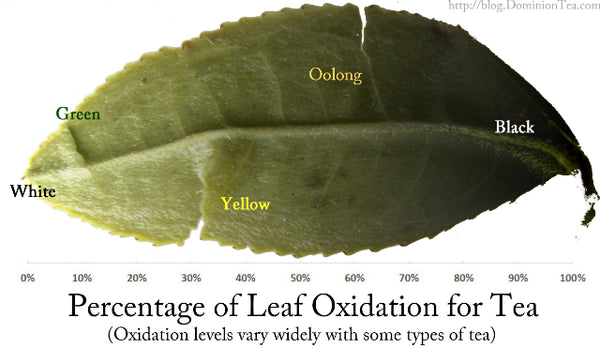Different levels of oxidation for different teas

Oxidation is a natural process that is important in tea production. In the past, oxidation was often inaccurately called fermentation. Although the term fermentation was in widespread use for a long time, it is misleading as there is no true fermentation (involving yeast or other micro-organisms) happening when tea oxidizes. The oxidation of tea is a key step in the production of tea that radically alters the flavour, appearance, and chemical composition of the tea leaf. This is instrumental in distinguishing the different types of tea from each other.
So what is oxidisation? It is a biochemical, enzymatic activity during which oxygen is absorbed, and subsequently causes changes to, the host physical matter. Oxidized teas are processed in a way that bruises the leaf, breaking cell walls and enabling enzymes in the leaves to cause natural oxidation reactions. These reactions are either allowed to carry out to completion, as in the case of most black tea, or are stopped by heating, as in the case of partially-oxidized oolongs. Unoxidised teas, like green tea, are heated earlier in the production process denaturing the enzymes in the leaf that cause oxidation before the leaves are able to oxidize.
A dark cup and one of the most popular teas is black. This has had the longest oxidation of any tea and is sometimes enjoyed with a splash of milk. Oolong tea is what is produced after an 80% oxidisation and green tea is usually unoxidised to help retain a light fresh taste. White teas are usually described as unoxidized teas like green teas. However, because of their minimal processing which does not kill the enzymes in the tea leaf as happens in the processing of green tea, white teas naturally experience some oxidation, so as a general rule, they are slightly more oxidized than typical green teas. This oxidation tends to be greatest in the larger-leafed white teas, because these leaves retain moisture (and thus stay biologically active) for a longer time during the withering process.
It is possible to quantify the oxidation of teas by measuring the portion of various unoxidized chemicals and their oxidized counterparts. However, because laboratory studies are costly, tea companies selling semi-oxidized teas usually make a subjective estimate of oxidation level of their teas based on colour and flavour claiming that a particular oolong tea for example is 30% oxidized or 70% oxidized. These claims are usually arbitrary estimates, but can be good coarse indicators of the character of a particular tea.



